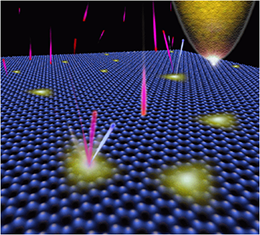|
Research
> Point defects in graphene systems
Point
defects in graphene systems
|
We
investigate, at the atomic scale, the impact that point
defects have in the structural, electronic and magnetic
properties of graphene layers grown on different materials. Such
defects are expected to have a dramatic impact in graphene
properties due to it’s pure bidimensionality.
Art
illustration of the generation and STM
analysis of individual
vacancies in graphene layers |

|
|
HOPG
|
|

By
selectively removing individual carbon atoms from the graphite surface,
we showed that vacancies lead to a dramatic reduction of the electronic
mobility and confirmed the creation of magnetic moments associated to
the vacancies in this pure carbon material, indicating a suitable route
to the creation of non-metallic, cheaper, lighter, and bio-compatible
magnets.
Physical
Review Letters 104, 096804 (2010)
[article]
 |
|
G/Pt(111)
|
|

Our
findings demonstrate that even in weakly coupled graphene/metal systems the
presence of the metal has to be seriously taken into account in order to
controllably tune graphene properties by locally modifying its structure. In
particular, we have demonstrated that the interaction with the metal
strongly increases when single C vacancies are introduced in the graphene
layer, discarding the appealing possibility of inducing magnetic properties
on this graphene system by removing C atoms.
Physical
Review Letters 107, 116803 (2011)
[article]
|
|
Divacancy
|
|

We
showed that carbon divacancies can be artificially introduced by ion
irradiation in several graphene systems. Our results reveal that such
divacancies accommodate two adjacent missing atoms in a planar structure
formed by two pentagons and one octagon (585 defect) with no dangling
bonds, being thus much less reactive than other vacancy-type defects. We
demonstrated that divacancies are expected to limit the electron mobility
and, unlike the case of monovacancies, they are a non-magnetic defect.
Physical
Review B 85,
121402 (R) (2012)
[article]


|
|

